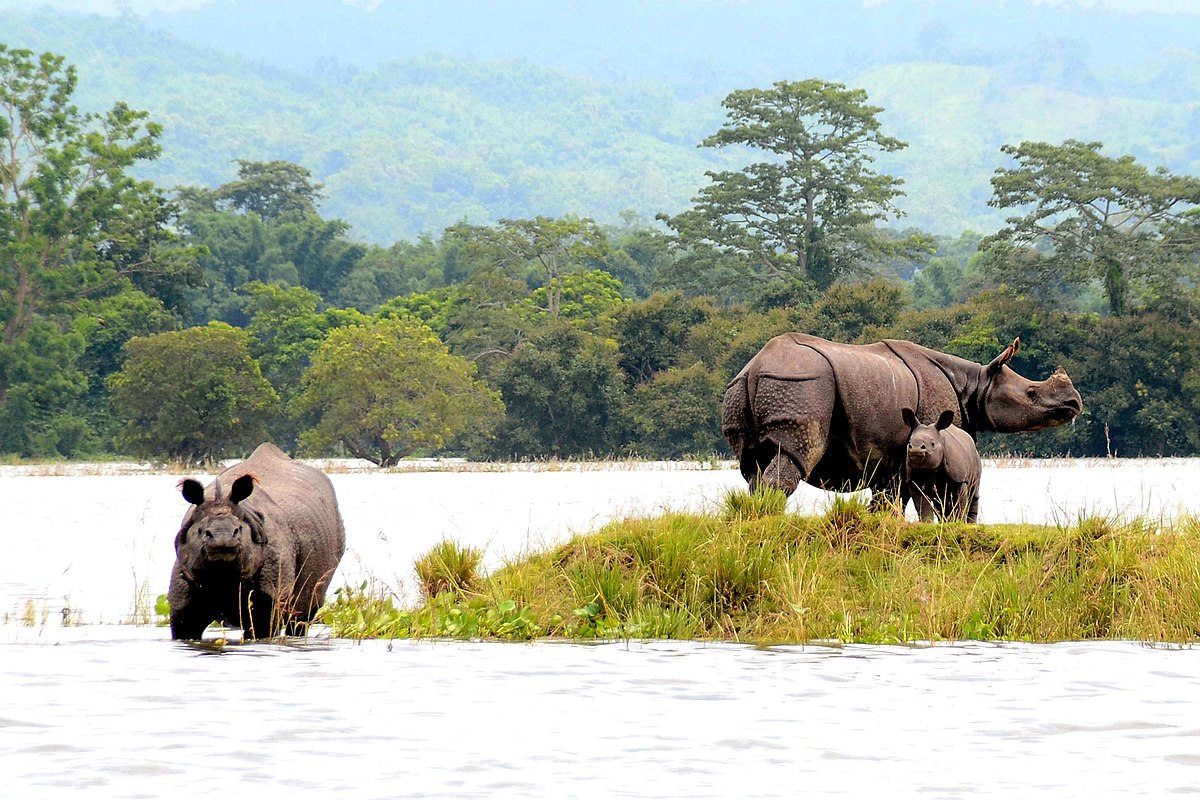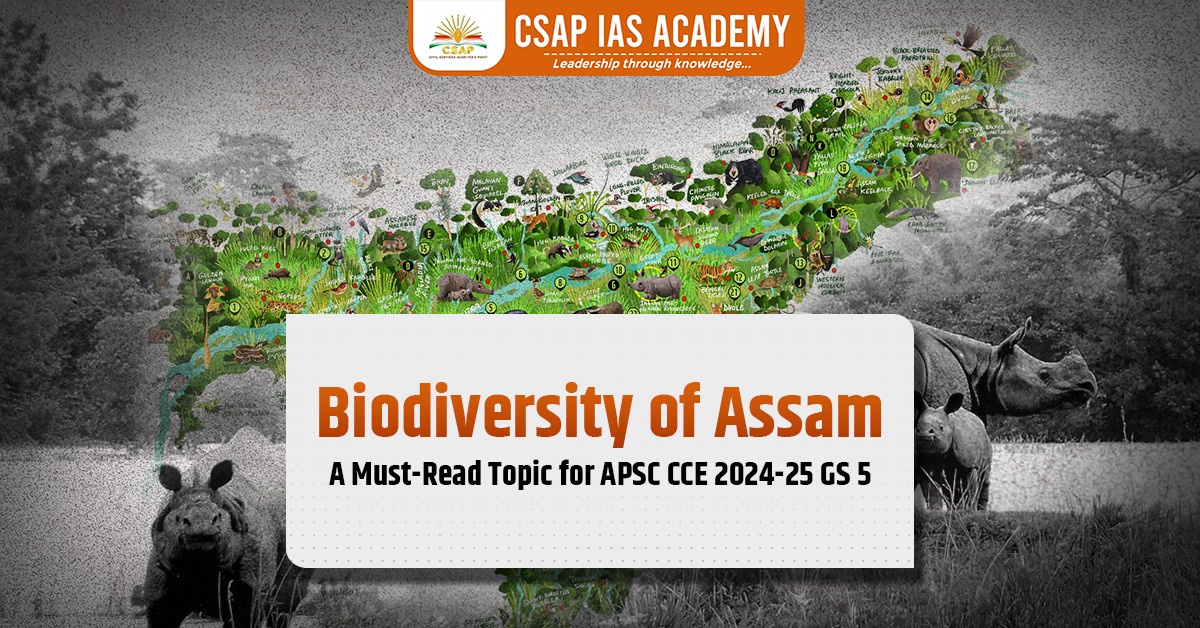The biodiversity of Assam, nestled in the heart of Northeast India, is a remarkable testament to nature’s richness and diversity. Home to a stunning array of flora, fauna, and ecosystems, the state forms a vital part of the Indo-Burma biodiversity hotspot. With its lush forests, mighty rivers, and unique wildlife, Assam plays a critical role in sustaining ecological balance.
In this article, we will discuss the biodiversity of Assam in detail, exploring its unique wildlife, rich habitats, conservation challenges, and its significance for sustainable development, especially for aspirants preparing for APSC CCE 2024-25 GS 5 Paper.
BIODIVERSITY OF ASSAM
Biodiversity means the totality of the varieties of organisms both plants and animals naturally present in a particular area. Assam is situated in the North Eastern part of India under tropical monsoon climate with west summer and cool dry winter. In general, the area experiences a relatively high average annual temperature and a heavy (though seasonal) average annual rainfall.
Such a condition is conclusive for luxuriant growth of vegetation providing suitable habitat for almost all varieties of life. The plants and animals of Assam have varieties from the Himalayan, Chinese, Indian and South East Asian zoo-geographic and Phyto-geographic.
Assam is regarded now as a part of the global biodiversity hotspot (only 2 in India). It is also a part of the Eastern Himalayas endemic bird area, Assam plains endemic bird area.
The geographical causes as to why the biodiversity of Assam is rich are the following:
- Arunachal Himalayas do not form an extensive snow covered region. So, many plants and animals from other zoo- geographical some regions are also available.
- There has been sustained human migration from Tibet and South East Asia to North East India. These migrants have brought in with them plants and animals that they considered to be useful.
- The area falls within the tropical zone with monsoon climate but the hills and land at sharp vertical variation precipitation. humidity, Thus, to temperature topography, and rainfall, temperature support different classified vegetations. The vegetations so developed form the basis of animal life.
- North East India is naturally one of the richest floristic regions of the world. It contains nearly half of the Indian plants so far identified and described.
PLANT DIVERSITY

Variations in ecological conditions have given rise to plant diversity in Assam.
- Tropical evergreen forest occurring mainly in Southern Parts of Jorhat, Sivasagar, Dibrugarh and Tinsukia district specially in the Jaipur to Margherita area, small areas of Himalayan foothills of Dhemaji, Lakhimpur and Sonitpur districts and in parts of North Cachar Hills and Barak Valley. This habitat is characterized by trees like Hallong, Mekai, Mesua families of trees. Presence of luxuriant orchids of all descriptions like Nahar and Macdolia.
- There are also tropical semi evergreen forests in the Himalayan foothills from Chirang district in BTAD to Joonai in Dhemaji district. Common varieties found here are Champa, Kadam, Nahar, Macdolia etc. This forest with their ground under decomposed leaves support many worms and insects. This in turn supports many amphibians, reptilians and other small mammalians.
- Assam also has coverage of tropical moist deciduous forest which occurred over a large area of lower Brahmaputra Valley and parts of Karbi Anglong and North Cachar Hills. The common trees of this forest are- Sal, Gomari, and Teak etc. The undergrowth is not very thick, thus supporting bigger mammalians like elephants, tigers, monkeys, deer etc.
- The river banks are found along the two of the largest rivers, thus supporting tall elephant grass like Konkua, Ikara, and Nal etc. This vegetation is known as Riparian vegetation.
Besides these habitats described above, the vast area occupied by man for long centuries have been supporting a number of species of domestic and semi domestic plants and animals.
ANIMAL DIVERSITY

It is mentioned earlier that among the mammals, Assam has as many as 230 forms; however total number of species identified is 175. The state has above 60% mammalian species of India.
It is found that some large river have formed effective barriers in the spread of some mammals. As for example the Brahmaputra is working as an effective barrier in the distribution of Hollock Gibbon which are confined to the South bank as opposed to Golden Langur which is confined to the north bank. Besides, about 90% of the Asian Rhinoceros and entire population of Pygmy hog of the world are found to be in Assam only.
The state also has very large wide Water buffalo, Elephants, Tigers, Leopards, and Golden Langur etc.
Assam is also rich in Avifauna. It has both fully terrestrial and swamp and aquatic birds. There are 958 species and sub- species of birds, out of which 208 are migrant which come during the winter season.
There are about 187 species of reptiles in Assam, which includes Crocodiles, Turtles, Tortoise, Lizards, and Snakes etc. Assam has many water bodies, swamps and marshes.
The amphibian population though limited in number, the number of species is very large so far the population is concerned. Among the amphibians giant frogs are very large in population in the state.
The state is also very rich in fish fauna. Example: Garoi. The hot and humid climate generally prevailing in this region modified specially by altitude has provided ideal habitat for almost all sorts of tropical and temperate flora and fauna.
PROBLEMS OF THE BIODIVERSITY OF ASSAM
- Assam is facing many problems in keeping the status of biodiversity unaffected with the rapid increase of population there has been ever increasing destruction of the environment felling of trees for various construction purposes, encroachment of forest areas for cultivation and habitations, clearing of vegetation for roads have taken a heavy toll of the forests of Assam in recent years. Between 1971-75, 1993-95 Assam has lost over 3142 sq km of dense forest. The percentage of dense forests in Assam came down to 19.8.
- In recent years some reserved forests and grazing land have been cleared to accommodate increasing population or those displaced due to ethnic clashes, bank erosions, chronic flood problems and high illegal immigrants from Bangladesh.
- Assam has also lost some good amount of frontier reserved forests during the time of land swap boundary agreement with Bangladesh and also due to disputes with the bordering states like Nagaland, Arunachal Pradesh, and Meghalaya etc.
- Some of the native habitats are under destruction due to uncontrolled grazing by domestic animals like goats, sheep, cattle etc.
- Poaching of rare animals for their hair, teeth, horn, skin etc also affected the biodiversity of the region. Sometimes some good wild animals are killed by electrocuting.
- Besides other serious problems notices due to climate change, high rise of bacterial, fungal and viral diseases different from plants and animals and change in the pattern of temperature and precipitation also has resulted into damage of the biodiversity of the region.
CONSERVATION OF BIODIVERSITY
There are some government laws aimed at protecting the habitats and the species of plants and animals, as for example, Forest Conservation Act 1990, Wildlife Protection Act 1972, and Environment Protection Act 1986. As per these laws, people are not allowed to occupy some forest or fell some trees, kill or capture some animals.
- Solid Waste Management Rules
- Paris Climate Agreement
- E-waste
- Proper implementation of central and state pollution board
- Use of CAMPA fund
Read: Monuments of Medieval Assam
Download App:











